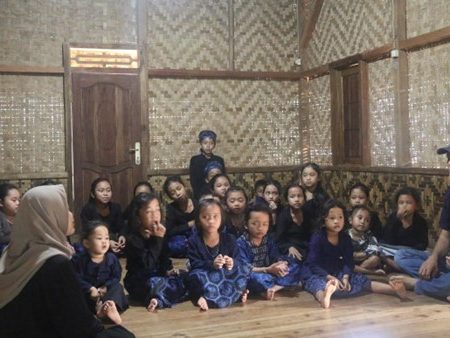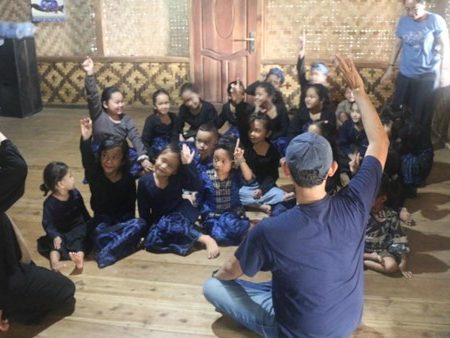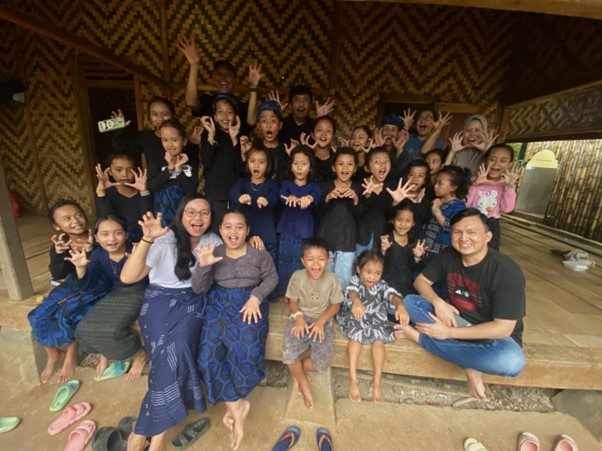
The Doctoral Program in Inter-Religious Studies, supported by the Indonesian Consortium for Religious Studies, conducted a community service activity with the central theme of digital literacy for children and teenagers in the Baduy Luar community, Banten (May 11, 2024). The team carried out this activity alongside ongoing polarization and digital inclusion research. The initiative stems from the awareness that digital literacy is crucial for children and teenagers, as most of them already use digital media, including those in the Baduy Luar community. Besides, this activity also aimed to support the implementation of SDGs goals 4, 10, and 11.
The Baduy community, with its unique cultural values and practices, remains relatively isolated from the outside world. It divides into two main groups, Baduy Dalam and Baduy Luar; they share the same ethnic and cultural background but differ significantly in lifestyle, customs, and interactions with the outside world. This distinctiveness underscores the importance of digital literacy in preserving their traditions and connecting them with the global community.
The Baduy Dalam community firmly maintains their traditional way of life and a ncestral customs. They live simple life, avoiding external influences. In their daily lives, Baduy Dalam people do not use modern technology such as electricity, transportation, and electronic devices (including digital media) and do not receive formal education. Most community members live by farming, using environmentally friendly materials like organic fertilizers and avoiding chemical fertilizers. The Baduy Dalam community limits interactions with outsiders. However, visitors are still allowed to come to Baduy Dalam as long as they adhere to the community’s strict rules, including not using technological devices while in Baduy Dalam. The Baduy Dalam community resides in three main villages: Cibeo, Cikawartana, and Cikeusik.
The Baduy Luar community is more open to external influences and changes. They live in villages surrounding Baduy Dalam and still uphold customs but are more flexible. Baduy Luar people interact more with outsiders and are open to working outside their community. They are also more involved in trade with the outside world. The Baduy Luar community is a popular tourist destination for local and international tourists. While their primary livelihood is farming, many have started developing small and medium enterprises, such as weaving, souvenir sales, tourism services, and many others. Baduy Luar people similar to Badui Dalam do not receive formal education but are allowed to learn independently. They have also started using modern technology on a limited scale, such as solar lamps and digital media (smartphones).
An interesting phenomenon among Baduy Luar children and teenagers is their use of smartphones and familiarity with social media. Instagram, TikTok, and YouTube are the most commonly used social media platforms. For communication, they all use WhatsApp. Some “TikTokers” from the Baduy Luar community have even gone viral, gaining substantial followings (reaching tens and hundreds of thousands of followers). The use of digital media by children and teenagers has both positive and negative impacts. Baduy Luar children and teenagers consider digital media help them learn and gain knowledge independently since they do not receive formal education. However, using digital media can also create a “disconnect” from traditions with previous generations, sometimes causing friction between generations.
Given these dynamics, the IRS program, supported by ICRS, conducted a community service activity focusing on digital literacy for children and teenagers in the Baduy Luar community. Dr. Leonard Chrysostomos Epafras was the leader of this research. Dr. Epafras presentation stated that digital literacy opens access to various educational resources that might not be available in the Baduy Luar community. Children and teenagers ability to utilize e-learning platforms, online courses, and digital educational materials to enhance their knowledge. They can indirectly reduce educational and social disparities between Baduy Luar children and teenagers and those outside their community, if these opportunities are well used.
Additionally, this activity aims to encourage children and teenagers to optimize their use of digital media. Baduy Luar children and teenagers are primarily users/followers, not producers/creators. Through this activity, the program encourages them to optimize their digital media usage, potentially becoming creators instead of followers. There is much potential that Baduy Luar children and teenagers can capitalize on to create creative, informative, and educative content. One example highlighted in this activity is how they are encouraged to document and promote their cultural values by making videos and photos that tell the daily life stories of the Baduy community. The benefits include the digital preservation of cultural values, cultural learning tools for young people, and the introduction of Baduy customs and culture to a broader community.
The equipping of Baduy Luar children and teenagers with digital literacy skills will open doors to social connectivity. They can now connect with friends from other communities, learn about diverse cultures, and expand their social networks. This enhanced social connectivity fosters mutual understanding, strengthens social cohesion within the Baduy Luar community, and paves the way for reduced inter-community friction.
Overall, digital literacy can be crucial in improving the quality of life for Baduy children and teenagers, especially in the Baduy Luar community. It’s about adopting technology and harnessing its full potential for education, cultural preservation, economic development, and social welfare. Baduy children’s digital literacy can maintain their cultural identity while reaping the benefits from other communities. Baduy’s children with this activity are also encouraged to become creators, not just followers.
Author: Hendrikus Paulus Kaunang



